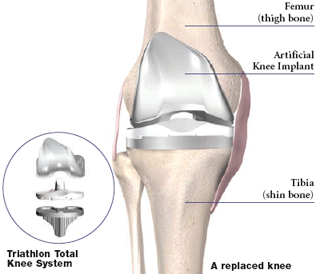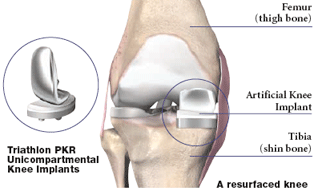Minimally Invasive Knee Joint Replacement
A Giant Step Forward in Knee Replacement
MIS Knee Joint Replacement is a giant step forward in knee replacement for a number of reasons, which may include a shorter hospital stay, less blood loss1 and potentially less scarring.
As you review this website, make a note of anything you don’t understand. Your orthopaedic surgeon will be happy to answer your questions so that you’ll feel comfortable with your chosen treatment plan.
Knee Replacement
Knee replacement is a surgical procedure — performed in the US since the 1960s — in which a diseased or damaged joint is replaced with an artificial joint called a prosthesis. Made of metal alloys and high-grade plastics (which are intended to mimic the function of bone and cartilage, respectively), the prosthesis is designed to move just like a healthy human joint. Over the years, knee replacement techniques and instrumentation have undergone countless improvements. Today, knee replacement is one of the safest and most successful types of major surgery; in well over 90% of cases it is complication-free and results in significant pain relief and restoration of mobility.
“I’m sorry I didn’t do something about it sooner, because there’s a world of difference.”
Christine Ricciardi, 57
Stryker Knee Replacement Recipient

MIS Knee Joint Replacement
Minimally Invasive Surgery
Over the past 25 years, minimally invasive surgery has revolutionized many fields of medicine. Its key characteristic is the use of specialized techniques and instrumentation that enable the physician to perform major surgery without a large incision. In this respect, MIS Knee Joint Replacement is indeed “minimally invasive,” requiring only a small incision and potentially causing less trauma to the soft tissues.
MIS Total Knee Replacement (TKR)
Unlike conventional TKR, which requires a large incision (8 to 12 inches) and significant disruption of the muscles and tendons, MIS Knee Joint Replacement is performed through a 3 to 4 inch incision. The amount of soft tissue (muscles and tendons, etc.) that is disrupted during surgery may also be reduced compared to conventional techniques.

MIS Partial Knee Resurfacing (PKR)
Partial Knee Resurfacing (PKR) is a minimally invasive procedure for relieving arthritic knee pain and disability. With PKR, only the damaged surface of the knee joint is resurfaced, potentially minimizing trauma to healthy bone and tissue. PKR implants were developed with patient needs in mind. Because the PKR implants are so much smaller than total knee implants, the surgical incision can be smaller as well.
Potential Advantages
Because fewer muscles and tendons are disturbed with the minimally invasive techniques, their reconstruction is often more natural, wound closure is easier, and recovery may be faster.1 Clinical studies have shown that the midvastus surgical approach used in the MIS technique results in less pain (at both 8 days and 6 weeks after surgery) and quicker restoration of muscle control and strength.2 It may take several months to recover from the large incision and muscle disruption that accompanies the standard approach.1
Risks Associated with Minimally Invasive Surgery
The MIS Knee Joint Replacement technique is less invasive than conventional TKR, but it is still a major surgery. It takes little additional time to complete and may result in advantages for the patient.
As with any major surgical procedure, patients who undergo total joint replacement are at risk for certain complications, the vast majority of which can be successfully avoided or treated. In fact, the complication rate following joint replacement surgery is very low. Serious complications, such as joint infection, occur in less than 2% of patients.3 (Besides infection, possible complications include blood clots, lung congestion, or pneumonia.) The risks that are normally encountered in conventional knee joint replacement remain.
You Don’t Have to Live with Severe Knee Pain
You don’t have to live with severe knee pain and the limitations it may put on your activities. If you haven’t experienced adequate relief with medication or other conservative treatments, MIS Knee Joint Replacement may provide relief from pain and enable you to return to your favorite activities.
For more information visit www.aboutStryker.com and contact your doctor.
